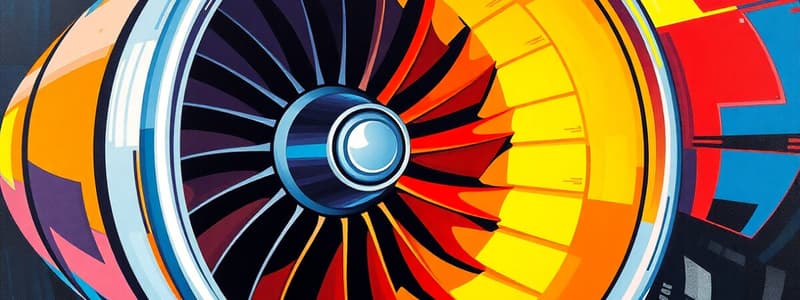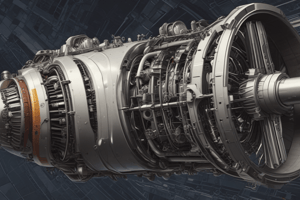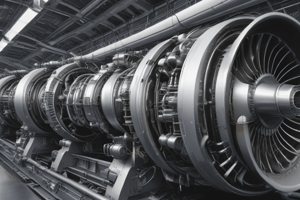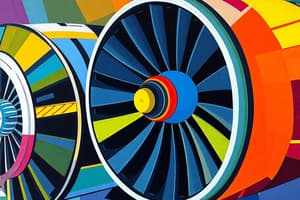Podcast
Questions and Answers
What two systems are essential for the satisfactory start of a gas turbine engine?
What two systems are essential for the satisfactory start of a gas turbine engine?
- Compressor/turbine rotation and ignition (correct)
- Exhaust gas recirculation and cooling
- Air intake and fuel preheating
- Fuel injection and lubrication
During the starting sequence, under what condition should a gas turbine engine be motored without ignition?
During the starting sequence, under what condition should a gas turbine engine be motored without ignition?
- Only during cold weather starts
- When fuel supply is limited
- When the engine is overheated
- For maintenance checks (correct)
For which engine is the starting procedure basically the same?
For which engine is the starting procedure basically the same?
- Rocket engines
- Gas turbine engines (correct)
- Reciprocating engines
- Piston engines
What is the primary role of the starter motor in a jet engine?
What is the primary role of the starter motor in a jet engine?
What type of electric motor is typically used in an electric starter for a gas turbine engine?
What type of electric motor is typically used in an electric starter for a gas turbine engine?
When does the electric starter in a gas turbine engine automatically disengage?
When does the electric starter in a gas turbine engine automatically disengage?
What is the primary advantage of using a cartridge starter on military engines?
What is the primary advantage of using a cartridge starter on military engines?
What drives the starter motor in a cartridge starting system?
What drives the starter motor in a cartridge starting system?
What component initiates the burning of the cartridge charge in a cartridge starter?
What component initiates the burning of the cartridge charge in a cartridge starter?
Which of the following best describes the function of the reduction gear and automatic disconnect mechanism in a cartridge starter system?
Which of the following best describes the function of the reduction gear and automatic disconnect mechanism in a cartridge starter system?
What is the primary advantage of using an isopropyl-nitrate starter?
What is the primary advantage of using an isopropyl-nitrate starter?
How is the fuel in an isopropyl-nitrate starter system ignited?
How is the fuel in an isopropyl-nitrate starter system ignited?
What is the function of the air pump in an isopropyl-nitrate starter system?
What is the function of the air pump in an isopropyl-nitrate starter system?
Which type of jet engines are air starters most commonly used on?
Which type of jet engines are air starters most commonly used on?
What is the main reason that air starters are often preferred in commercial aviation?
What is the main reason that air starters are often preferred in commercial aviation?
What are the sources of air used to rotate the turbine in an air starter system?
What are the sources of air used to rotate the turbine in an air starter system?
What component automatically disengages the clutch in an air starter system?
What component automatically disengages the clutch in an air starter system?
What does a gas turbine starter primarily consist of?
What does a gas turbine starter primarily consist of?
What type of starter system is typically used in a gas turbine starter?
What type of starter system is typically used in a gas turbine starter?
How is the free-power turbine connected to the main engine in a gas turbine starter?
How is the free-power turbine connected to the main engine in a gas turbine starter?
Which engines are hydraulic starters typically utilized for?
Which engines are hydraulic starters typically utilized for?
What provides the pressure to rotate the pump/starter in a hydraulic starting system?
What provides the pressure to rotate the pump/starter in a hydraulic starting system?
Which of the following is NOT a major component of a turbine engine ignition system?
Which of the following is NOT a major component of a turbine engine ignition system?
Where does the exciter receive power from in a turbine engine ignition system?
Where does the exciter receive power from in a turbine engine ignition system?
What is the function of the igniter plug in a turbine engine ignition system?
What is the function of the igniter plug in a turbine engine ignition system?
What is a key difference between Intermittent Duty and Extended Duty ignition systems?
What is a key difference between Intermittent Duty and Extended Duty ignition systems?
What is the primary advantage of using an ignition system with a low joule output under certain flight conditions?
What is the primary advantage of using an ignition system with a low joule output under certain flight conditions?
Which of the following describes a characteristic shared by all high-energy (H.E.) ignition systems in jet engines?
Which of the following describes a characteristic shared by all high-energy (H.E.) ignition systems in jet engines?
What is the minimum potential difference that is required to ionize the air gap in an igniter plug?
What is the minimum potential difference that is required to ionize the air gap in an igniter plug?
What voltage requirement distinguishes a surface discharge igniter plug from an air gap type igniter plug?
What voltage requirement distinguishes a surface discharge igniter plug from an air gap type igniter plug?
What is the primary purpose of an internal air system in a gas turbine engine?
What is the primary purpose of an internal air system in a gas turbine engine?
What is the general fraction of the total engine core mass airflow that is dedicated to the internal air system?
What is the general fraction of the total engine core mass airflow that is dedicated to the internal air system?
Air is drawn from the compressor as early as possible to reduce what?
Air is drawn from the compressor as early as possible to reduce what?
Which engine components are the main areas that need air cooling?
Which engine components are the main areas that need air cooling?
How does cooling air impact engine efficiency?
How does cooling air impact engine efficiency?
What is a common method for cooling turbine components?
What is a common method for cooling turbine components?
Where is bleed air typically directed in convection cooling/film cooling?
Where is bleed air typically directed in convection cooling/film cooling?
What components is transpiration cooling used on?
What components is transpiration cooling used on?
In which direction is bleed air ducted on stationary nozzle vanes?
In which direction is bleed air ducted on stationary nozzle vanes?
When atmospheric air is used to cool an accessory unit, what is needed for that system to work when the aircraft is static?
When atmospheric air is used to cool an accessory unit, what is needed for that system to work when the aircraft is static?
Flashcards
Gas Turbine Engine Starting
Gas Turbine Engine Starting
Systems needed to rotate compressor/turbine to a speed allowing sufficient air into combustion and provide ignition.
Cartridge Starting
Cartridge Starting
A quick, independent starting method for military engines relying on high-velocity gases.
Isopropyl-nitrate starter
Isopropyl-nitrate starter
Starter that gives rapid starting using a turbine rotated by high pressure gases from combustion.
Air Starting
Air Starting
Signup and view all the flashcards
Gas Turbine Starter
Gas Turbine Starter
Signup and view all the flashcards
Hydraulic Starter
Hydraulic Starter
Signup and view all the flashcards
Turbine Engine Ignition System
Turbine Engine Ignition System
Signup and view all the flashcards
Intermittent Duty Ignition
Intermittent Duty Ignition
Signup and view all the flashcards
Extended Duty Ignition
Extended Duty Ignition
Signup and view all the flashcards
Igniter Plug Types
Igniter Plug Types
Signup and view all the flashcards
Internal Air System
Internal Air System
Signup and view all the flashcards
Engine Cooling
Engine Cooling
Signup and view all the flashcards
Cooling Air Purpose
Cooling Air Purpose
Signup and view all the flashcards
Convection/Film Cooling
Convection/Film Cooling
Signup and view all the flashcards
Transpiration Cooling
Transpiration Cooling
Signup and view all the flashcards
Accessory Cooling
Accessory Cooling
Signup and view all the flashcards
Seals
Seals
Signup and view all the flashcards
Study Notes
Starting a Gas Turbine Engine
- Gas turbine engines require two separate systems for a successful start
- Provision must be made to rotate the compressor and turbine
- Rotation ensures adequate airflow into the combustion system for proper fuel mixing via spray nozzles
- Sufficient engine speed is required to reach engine idling RPM
Ignition Systems
- Ignition of the air/fuel mixture in the combustion system must be provided
- The two starting systems operate simultaneously during engine start
- The engine can be motored without ignition for maintenance
- The ignition system can operate alone for relighting mid-flight
Methods of Starting Jet Engines
- The starting procedure is the same across all jet engines
- Methods to achieve the procedure can vary
- A starter motor must generate high torque
- The starter motor needs to transfer the torque to the rotating engine assembly
- Smooth acceleration from rest should be provided
- Acceleration should occur until the gas flow offers sufficient power for the engine turbine to take over
Types of Starters
- Electric Starter
- Cartridge Starter
- Isopropyl-Nitrate Starter
- Air Starter
- Gas Turbine Starter
- Hydraulic Starter
Electric Starters
- Electric starters typically use a direct current (D.C.) electric motor
- These motors are linked to the engine using a reduction gear and ratchet mechanism or clutch
- The clutch automatically disengages when the engine achieves self-sustaining speed
- It provides power to operate the ignition system
- When the starter load decreases after engine start, or when the time cycle ends, electrical supply is automatically cut
Cartridge Starters
- Cartridge starting can be used in military engines
- It is a quick, independent starting method
- A starter motor features an impulse-type turbine
- The turbine is propelled by high-velocity gases produced by a burning cartridge
- An electrically fired detonator starts the cartridge burning
- The turbine's power goes through a reduction gear
- An automatic disconnect mechanism rotates the engine
Isopropyl-nitrate Starters
- Provides high power output
- It has rapid starting characteristics
- This starter type uses a turbine
- The turbine transmits power to the engine through a reduction gear
- High-pressure gases from isopropyl-nitrate combustion rotates the turbine
- Fuel is sprayed into a combustion chamber then electrically ignited with a high energy ignition system
- A pump delivers fuel from a storage tank to the combustion chamber
- An air pump removes fumes from combustion chamber before each fresh start
Air Starters
- Air starting sees use on most commercial and some military jet engines
- Offers advantages like being light, simple, and economical
- An air starter motor transfers power via reduction gear and clutch
- It transfers power to the output shaft that connects to the engine
- The starter turbine is rotated by air
- The air is supplied by an external ground source, an auxiliary power unit (APU), or cross-feed from a running engine
- An electrically operated control and pressure reducing valve controls the air supply
- The clutch automatically disengages when the engine rpm reaches idling speed, stopping starter rotation
Gas Turbine Engine Starters
- Used for some jet engines
- Completely self-contained
- Possesses its own fuel, ignition and starting system (typically electric or hydraulic)
- A self-contained oil system is included
- Cost-effective to operate
- Produces high power relative to low weight
- Features a small, compact gas turbine engine
- Usually includes a turbine-driven centrifugal compressor
- A reverse flow combustion system operates within
- Has a mechanically independent free-power turbine
- The free-power turbine connects to the main engine
- This occurs via a two-stage epicyclic reduction gear, automatic clutch, and output shaft
Hydraulic Starters
- Used for starting smaller jet engines
- Torque is transmitted to the engine in various ways
- A typical system includes a reduction gear and clutch setup
- Hydraulic pressure derived from a ground supply unit rotates the pump/starter
Engine Ignition Systems
- A turbine engine ignition system consists of:
- A high voltage exciter
- A high voltage transmission lead
- An igniter plug
- The exciter gets power from the aircraft electrical system (DC or AC)
- A permanent magnet alternator (PMA) can be used instead
- The exciter produces a high voltage pulse
- The pulse travels through the igniter lead to the plug
- The igniter plug arcs, causing a spark that ignites the fuel/air mixture in the combustion chamber
Modern Ignition Systems
- Modern gas turbine engine ignition systems are capacitor discharge type
- Either of the Intermittent Duty or Extended Duty cycles can be used
- Intermittent Duty types employ sufficient high current
- This can cause units to overheat and damage
- The Intermittent Duty types have a restricted duty cycle based on operating time followed by a cooling period
- Extended Duty types feature long duty cycles
- Some Extended Duty types are rated for continuous duty with no time limits
- Ignition isn't needed after a normal start
- The ignition system is then deactivated
- High-energy (H.E.) ignition is used to start all jet engines
- A dual system is always installed
- Each system has an ignition unit
- An igniter plug is connected to its ignition unit
- The set of two plugs are placed in the combustion system at different positions
- Ignition units are measured in Joules
- Units give varied outputs to meet requirements
- A high output value (12 joules for example) ensures satisfactory relight at high altitudes or start
Alternative Ignition Units
- A low value output between 3 to 6 joules is preferred in conditions like icing or heavy precipitation
- It results in a longer life for the igniter plug and ignition unit
Igniter Plugs
- Two primary igniter plug types feature;
- Constricted or constrained air gap type
- Shunted surface discharge type
- The air gap type is like a reciprocating engine spark plug, but has a larger air gap
Voltage in Igniters
- A potential difference of approximately 25,000 volts is needed to ionize the gap before a spark
- High voltage requires excellent circuit insulation
- The surface discharge igniter plug features a semiconducting pellet
- This allows electrical leakage from the central high tension electrode to the grounded body
- The ionizing surface of the pellet makes a low resistance path for energy stored in the capacitor
- A high-intensity flashover happens between the electrode and body and requires approximately 2000 volts to work
Internal Air System
- Refers to airflows that do not directly contribute to engine thrust
- It provides air for the aircraft's systems
- Can use up to a fifth of total engine core mass airflow for various tasks
- To limit engine perfomance losses, air is tapped as early as possible from the compressor
- Tapping position varies according to the demands of each function
Cooling Considerations in Jet Engines
- It has to be ensured that various parts of the engine and accessories do not absorb detrimental heat
- The combustor and turbine require air cooling
- Cooling air controls temperature of compressor shafts and discs with cooling or heating
- Equal temperature distribution ensures improves thermal efficiency
- Ensures minimal blade tip and seal clearances
Turbine Cooling
- High thermal efficiency is dependent upon high entry temperature
- High entry temp is limited by the turbine blade and nozzle materials
- Components must be continuously cooled
- Continuous cooling means their temperatures can exceed the material's melting point without risk to blade and vane integrity
- Heat transfer needs the cooling of the discs
- Disc cooling prevents thermal fatigue and uncontrolled expansion and contraction
- The most popular methods of cooling are using engine bleed air
- Convection cooling/film cooling
- Transpiration cooling
- Compressor bleed air is directed inside through the hollow blades
- It then exits through holes in the tip, leading edge, and trailing edge in convection cooling
- Transpiration cooling is restricted to only stationary nozzle vanes
- They are connected to bleed air
- The air exits through the porous material
- Early engines employed single pass internal (convection) cooling
- Impingement cooling of vanes with external air film cooling of vanes and blades arrived later
Accessory Cooling
- Accessories generate substantial heat needing cooling
- Accessories like electrical generators require their own cooling circuit
- When air acts a coolant, it can be derived from the compressor
- Atmospheric air that is ducted from intake louvres in the engine cowlings can also supply the coolant
- When accessory unit is cooled with atmospheric air in flight, another circuit is generally required
- It's needed for use during static ground running when there's no atmospheric coolant
- Accomplished by feeding compressed air via nozzles to the air outlet duct of the accessory
- Air velocity forms a low pressure area and forms an ejector
- It induces atmospheric air flow through intake louvres
- Compressor air operates the ejector system
- A valve controls the flow of air
Gas Turbine Engine Sealing Methods
- Choice relies on:
- Surrounding temperature
- Pressure
- Wearability
- Heat generation
- Weight
- Space
- Ease of manufacture
- Ease of installation and removal
- Seals are used:
- To stop oil leakage from engine bearings
- To control cooling airflows
- To prevent entry of mainstream gas into turbine disc cavities
Types of Seals
- Labyrinth
- Ring
- Hydraulic
- Carbon
- Brush
Studying That Suits You
Use AI to generate personalized quizzes and flashcards to suit your learning preferences.




